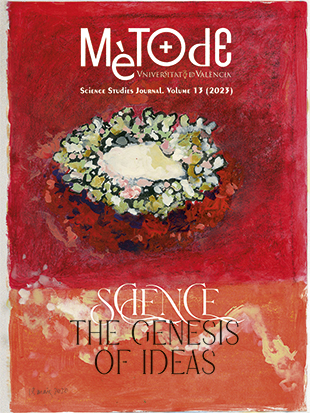Ciencia y política contra la desertificación: La respuesta de las instituciones ante un reto global
DOI:
https://doi.org/10.7203/metode.13.21901Palabras clave:
CNULD, zonas áridas, degradación de tierras, sequía, interfaz ciencia-política Resumen
Resumen
La desertificación es un concepto controvertido del que aún se discute su naturaleza, extensión, causas y posibles soluciones. En este artículo se revisan los argumentos esgrimidos para situar la desertificación como un gran reto ambiental global y se describe la respuesta institucional dentro del sistema de las Naciones Unidas, en especial la que representa la Convención de Naciones Unidas de Lucha contra la Desertificación (CNULD). Los elementos más significativos del debate sobre la desertificación son analizados atendiendo a sus dimensiones científicas y políticas. Se concluye en la necesidad de establecer un marco integrado de evaluación y respuesta ante la desertificación validado por una interfaz entre ciencia y política.
 Descargas
Descargas
 Citas
Citas
Akhtar-Schuster M., Amiraslani, F., Diaz Morejon, C. F., Escadafal, R., Fulajtar, E., Grainger, A., Kellner, K., Khan, S. I., Perez Pardo, O., Sauchanka, U., Stringer, L. C., Reda, F., & Thomas, R. J. (2016). Designing a new science-policy communication mechanism for the UN Convention to Combat Desertification. Environmental Science & Policy, 63, 122–131. https://doi.org/10.1016/j.envsci.2016.03.009
Carr, S., & Mpande, R. (1996). Does the definition the issue matter? NGO influence and the international Convention to Combat Desertification in Africa. The Journal of Commonwealth and Comparative Politics, 34(1), 143–166. https://doi.org/10.1080/14662049608447720
Corell, E. (1999). The negotiable desert: Expert knowledge in the negotiations of the convention to combat desertification. Linkoping Studies in Arts and Science No. 191. Linkoping University.
King, C., & Thomas, D. S. G. (2014). Monitoring environmental change and degradation in the irrigated oases of the Northern Sahara. Journal of Arid Environments, 103, 36–45. https://doi.org/10.1016/J.JARIDENV.2013.12.009
Martinez-Valderrama, J., Guirado, E., & Maestre, F. T. (2020). Desertifying deserts. Nature Sustainability, 3, 572–575. https://doi.org/10.1038/s41893-020-0561-2
Martinez-Valderrama, J., Sanjuan, M. E., del Barrio, G., Guirado, E., Ruiz, A., & Maestre, F. T. (2021). Mediterranean landscape re-greening at the expense of South American agricultural expansion. Land, 10(2), 204. https://doi.org/10.3390/land10020204
Mirzabaev, A., Wu, J., Evans, J., Garcia-Oliva, F., Hussein, I. A. G., Iqbal, M. H., Kimutai, J., Knowles, T., Meza, F., Nedjraoui, D., Tena, F., Turkeş, M., Vazquez, R. J., & Weltz, M. (2019). Desertification. In P. R. Shukla, J. Skea, E. Calvo Buendia, V. Masson-Delmotte, H.-O. Portner, D. C. Roberts, P. Zhai, R. Slade, S. Connors, R. van Diemen, M. Ferrat, E. Haughey, S. Luz, S. Neogi, M. Pathak, J. Petzold, J. Portugal Pereira, P. Vyas, E. Huntley, … J. Malley (Eds.). Climate change and land: An IPCC special report on climate change, desertification, land degradation, sustainable land management, food security, and greenhouse gas fluxes in terrestrial ecosystems. IPCC.
Mortimore, M. (2016). Changing paradigms for people-centred development in the Sahel. In R. Behnke & M. Mortimore (Eds.), The end of desertification? (pp. 65–98). Springer. https://doi.org/10.1007/978-3-642-16014-1
Mortimore, M., Anderson, S., Cotula, L., Davies, J., Faccer, K., Hesse, C., Morton, J., Nyangena, W., Skinner, J., & Wolfangel, C. (2009). Dryland opportunities: A new paradigm for people, ecosystems and development. IUCN, IIED, & UNDP/DDC.
Porter, G., & Brown, J. W. (1991). Global environmental politics. Westview Press.
Safriel, U. (2009). Deserts and desertification challenges but also opportunities. Land Degradation and Development, 20, 353–366.
Stafford-Smith, D. M. (2016). Desertification: Reflections on the mirage. In R. Behnke & M. Mortimore (Eds.). The end of desertification? (pp. 539–560). Springer. https://doi.org/10.1007/978-3-642-16014-1
Stafford-Smith, D. M., & Reynolds, J. F. (2002). The Dahlem desertification paradigm: A new approach to an old problem. In J. F. Reynolds & D. M. Stafford-Smith (Eds.), Global desertification. Do humans cause deserts? (pp. 403–424). Dahlem University Press.
Stringer, L. (2008). Can the UN Convention to Combat Desertification guide sustainable use of the world’s soils? Frontiers in Ecology and the Environment, 6(3), 138–144. https://doi.org/10.1890/070060
Thomas, R. J., Akhtar-Schuster, M., Stringer, L. C., Marques, M. J., Escadafal, R., Abraham, E., & Enne, G. (2012). Fertile ground? Options for a science-policy platform for land. Environmental Science & Policy, 16, 122–135. https://doi.org/10.1016/j.envsci.2011.11.002
Thomas, D. S. G., & Middleton, N. (1994). Desertification: Exploding the myth. John Wiley & Sons.
Tiffen, M., Mortimore, M., & Gichuki, F. (1994). More people less erosion: Environmental recovery in Kenya. John Wiley.
Toulmin, C. (2001). Lessons from the theatre: Should this be the final curtain call for the Convention to Combat Desertification? WSSD Opinion Series. International Institute for Environment and Development.
Toulmin, C., & Brock, K. (2016). Desertification in the Sahel: Local practices meets global narrative. In R. Behnke & M. Mortimore (Eds.), The end of desertification? (pp. 37–64). Springer. https://doi.org/10.1007/978-3-642-16014-1
UNCCD. (1994). The United Nations Convention to Combat Desertification in those countries experiencing serious droughts and/or desertification, particularly in Africa. Secretariat of the United Nations Convention to Combat Desertification.
Verstraete, M. M. (1986). Defining desertification: A review. Climate Change, 9, 5–18. https://doi.org/10.1007/BF00140520
Vogel, C., H., & Smith, J. (2002). Building social resilience in arid ecosystems. In J. F. Reynolds & D. M. Stafford-Smith (Eds.), Global desertification. Do humans cause deserts? (pp. 149–166). Dahlem University Press.
Descargas
Publicado
Cómo citar
-
Resumen1660
-
PDF 690
Número
Sección
Licencia
![]()
Todos los documentos incluidos en OJS son de acceso libre y propiedad de sus autores.
Los autores que publican en esta revista están de acuerdo con los siguientes términos:
- Los autores conservan los derechos de autor y garantizan a Metode Science Studies Journal el derecho a la primera publicación del trabajo, licenciado bajo una licencia de Creative Commons Reconocimiento-NoComercial-SinObraDerivada 4.0 Internacional, que permite a otros compartir el trabajo con un reconocimiento de la autoría del trabajo y citando la publicación inicial en esta revista.
- Se permite y se anima a los autores a difundir sus trabajos electrónicamente a través de páginas personales e institucionales (repositorios institucionales, páginas web personales o perfiles a redes profesionales o académicas) una vez publicado el trabajo.





